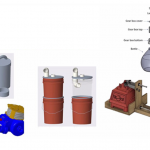PURPOSE
To help develop self-regulation, but with explicit instructional guidance
DESCRIPTION
Scaffolded coursework that incorporates a series of authentic and non-trivial “mini-projects”; real-world products; independent research (alone or in teams); analysis-, synthesis- and reflective practice
UNDERLYING EDUCATIONAL THEORIES
Self-regulation, self-efficacy, peer learning, constructivist, discovery, problem-based, project-based, inquiry-based, Zone of Proximal Development, Disequilibrium, constructive argumentation
PEDAGOGICAL BENEFITS
- A series of mini-projects is not merely a collection of discrete learning units, but rather a scaffolded learning platform that is flexible enough to accommodate the individual needs and desires of students.
- Series of mini-projects should be harmoniously integrated with other course elements, (e.g., lectures, quizzes, homework assignments, etc..)
- Pedagogically, the mini-projects aim to move students from a simple to a complex level of understanding; for example, moving beyond simply grasping how a tool is employed to understanding its purpose, the need(s) it addresses, and the expectations surrounding its use.
- Adding opportunities for flexibility in pursuing some of their own interests can further challenge students to look beyond the tools employed in the engineering profession and recognize the fundamental relationships between acquiring foundational knowledge and developing personal expertise.
- As students progress through the sequence of mini-projects, their tasks become more complex and ill-defined to require independent research. The value of allowing students to engage with an ill-defined problem space, especially before they have obtained much of the knowledge necessary for analysis and design, is that doing so can lead them into a state of productive struggle that can foster a capacity to identify and take responsibility for their own knowledge needs.
STRATEGIES FOR IMPLEMENTATION
- Course material is divided into “bite-size” chunks, with each chunk representing a core aspect of the syllabus. These chunks are then crafted into a series of mini-projects, usually between five and eight, that are offered as team-based or solo assignments.
- Students should ideally work in 4 members per team. This insures that each member will have reasonable opportunity to contribute and learn from others. (Too large teams lead to “free riding” or fragmentation of team.) Teams should be permanent to enable improved functionality with time. At least one of the mini-projects should be solo-based for students to show individual competencies.
- Questions are set-up so that they are dependent on one another, to facilitate effective teamwork.
- Each mini-project should contain aspects pertaining to well-defined analytical problems, open-ended synthesis (design) problems, and reflective questions. Students should be able to customize their synthesis (design) questions or to choose their own topics.
- While some questions could contain background theory and hints, they should be designed to require students to perform rigorous research to identify theory-backed solution techniques. When doing reflective work, students combine “how to” with “why” questions and learn to form individualized value judgments. Reflective exercises also activate emotional awareness which can lead to students “knowing that they know something”.
- The first mini project in a series should preferably be team-based and is intended to build confidence in foundational concepts. Each subsequent project builds on the previous, eventually culminating in students performing solo-based mini projects. The projects could begin with well-defined tasks and progress to open-ended design tasks with ill-defined questions. The removal of scaffolds over time relies on the assumption that students are adapting to, and developing strategies for, these tasks, meaning that as they develop as designers or engineers, they are more capable of exploring and planning within an open-ended space.
- These projects could make up the bulk (say, 60%) of formative assessments thereby shifting the focus from high-stakes exam performance to lower-stakes project performance. This would signal to students that they would be assessed on both technical skill development and the acquisition of knowledge necessary to understand, utilize, create, and communicate their ideas. This assessment method also adapts well to both face-to-face and online course settings, making it both a practical pedagogical strategy and one that allows for comparative data collection on student learning experiences in-class and online.
- Students should be tasked to peer-evaluate each other’s assignments, facilitating peer-to-peer learning. Detailed grading rubrics and grading keys should be provided. Team members should perform peer evaluation to help insure individual accountability.
EXAMPLES
Final individual Mini-Project (Design for repurpose) for ME270 FA20
REFERENCES AND FURTHER READING
Tucker, T., Dancholvichit, N., Wolf, A., Liebenberg, L, “Transforming an Engineering Design Course into an Engaging Learning Experience using a Series of Self-Directed Mini Projects and ePortfolios,” in The 128th ASEE Annual Conference [Technical Session], 2021. The American Society for Engineering Education: Long Beach, CA (Virtual Conference).
